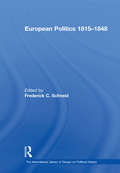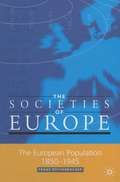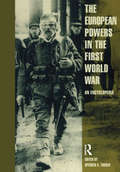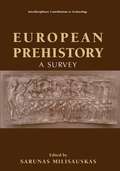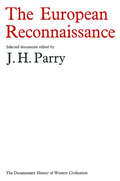- Table View
- List View
European Political History 1870–1913 (The International Library of Essays on Political History)
by Thomas MergelThe period from 1870 to 1913 saw the emergence of modern mass politics. The extension of the franchise, the development of party structures and political cleavages and growing state intervention mark this period as one of substantial political change. This collection brings together a selection of the most important recent research in this field.
European Political History 1870–1913 (The International Library of Essays on Political History)
by Thomas MergelThe period from 1870 to 1913 saw the emergence of modern mass politics. The extension of the franchise, the development of party structures and political cleavages and growing state intervention mark this period as one of substantial political change. This collection brings together a selection of the most important recent research in this field.
European Political Thought 1600–1700 (European Culture and Society)
by W. M. SpellmanThe European seventeenth century saw the seeming resolution of two great conflicts.Through the nightmares of the Thirty Years War and the British civil wars, the murderous religious hatreds that had dominated the previous period finally burnt themselves out. Extreme Protestants were defeated, expelled, contained or subordinated, and Catholicism successfully re-established itself through much of Europe as the dominant religion.Dr. Spellman studies all the great political theorists of the century (dominated inevitably by Hobbes). This book will be invaluable for anyone studying seventeenth century European history - it allows those studying the thought of the period to understand the historical context, and those studying the military and political events to understand their intellectual underpinning.
European Politics 1815–1848 (The International Library of Essays on Political History)
by Frederick C. SchneidThe three intervening decades between the Congress of Vienna and the Revolutions of 1848 are marked by enormous social, political, economic and cultural change. Liberalism, nationalism, romanticism and industrialism profoundly affected the course of Europe and compelled conservative monarchies to accept the principles of collective action and military force to curb political revolution. In the years immediately following 1815, the Quadruple and Holy Alliances served the dual purpose of preventing a restoration of Bonapartism and suppressing revolutions. By the 1820s these international associations dissipated, but the principles upon which they were founded informed the decisions of the respective governments through 1848. The classic articles and papers collected in this volume attempt to illustrate that despite the substantial changes to European society which occurred during these thirty years, European powers accepted common principles which influenced their state's domestic and foreign policies.
European Politics 1815–1848 (The International Library of Essays on Political History)
by Frederick C. SchneidThe three intervening decades between the Congress of Vienna and the Revolutions of 1848 are marked by enormous social, political, economic and cultural change. Liberalism, nationalism, romanticism and industrialism profoundly affected the course of Europe and compelled conservative monarchies to accept the principles of collective action and military force to curb political revolution. In the years immediately following 1815, the Quadruple and Holy Alliances served the dual purpose of preventing a restoration of Bonapartism and suppressing revolutions. By the 1820s these international associations dissipated, but the principles upon which they were founded informed the decisions of the respective governments through 1848. The classic articles and papers collected in this volume attempt to illustrate that despite the substantial changes to European society which occurred during these thirty years, European powers accepted common principles which influenced their state's domestic and foreign policies.
The European Population, 1850-1945 (Societies of Europe)
by F. RothenbacherThe European Population, 1850-1945 is the first volume of two on demographics. The second volume will appear as part of the Societies of Europe series in 2003 and will cover changes until the year 2000. The European Population, 1850-1945 is a comparative and historical data handbook and accompanying CD-ROM presenting series data on demographic developments, population and household structures for the countries of Western and Central Europe. All major fields of demographic change are covered: fertility, mortality, marriage, and divorce. Population figures are given for each population census by sex, civil status and age. Major demographic developments within the family are described providing a commentary on the main population structures and trends in Europe since the 19th century.
European Portugal: The Difficult Road to Sustainable Democracy
by J. MagoneThis book analyses the Europeanization of the Portuguese political system in the context of globalization and the so-called Third Wave of Democratization. It pursues the thesis that democratization and Europeanization are two intertwined processes in the case of Portugal. Integration into the European Union has changed considerably the rationalities within the political structures of the Portuguese political system. Furthermore, the author stresses the necessity to encourage greater political participation of the population and to evolve towards a project of sustainable democracy.
European Powers in the First World War: An Encyclopedia
by Spencer TuckerFirst published in 1996. The First World War was the single most important event of the twentieth century. This volume concentrates on non-U.S. aspects of the conflict. Organized alphabetically, its more than 600 detailed entries offer information and insight on such subjects as the causes of the conflict, major battles and campaigns, weapons systems (including military aviation, chemical warfare, the submarine, and the tank), and the terms of the peace. Some 350 biographies provide information on the roles played in the conflict by generals, admirals, and civilian leaders. There are also biographies of individuals who were shaped by the war, such as Charles De Gaulle, Adolf Hitler, Benito Mussolini, and Joseph Stalin; essays on each of the countries involved in the conflict; new appraisals of such subjects as military medicine and artillery tactics; and essays on such diverse subjects as art, literature, and music in the war. Each entry has references for additional reading, and a subject index provides easy access. The volume is an excellent reference source for scholar and neophyte alike.
European Powers in the First World War: An Encyclopedia (Military History Of The United States Ser.)
by Spencer C. Tucker Laura Matysek Wood Justin D. MurphyFirst published in 1996. The First World War was the single most important event of the twentieth century. This volume concentrates on non-U.S. aspects of the conflict. Organized alphabetically, its more than 600 detailed entries offer information and insight on such subjects as the causes of the conflict, major battles and campaigns, weapons systems (including military aviation, chemical warfare, the submarine, and the tank), and the terms of the peace. Some 350 biographies provide information on the roles played in the conflict by generals, admirals, and civilian leaders. There are also biographies of individuals who were shaped by the war, such as Charles De Gaulle, Adolf Hitler, Benito Mussolini, and Joseph Stalin; essays on each of the countries involved in the conflict; new appraisals of such subjects as military medicine and artillery tactics; and essays on such diverse subjects as art, literature, and music in the war. Each entry has references for additional reading, and a subject index provides easy access. The volume is an excellent reference source for scholar and neophyte alike.
European Prehistory: A Survey (Interdisciplinary Contributions to Archaeology)
by Sarunas MilisauskasSarunas Milisauskas· 1.1 INTRODUCTION The purpose of this book is four-fold: to introduce English-speaking students and scholars to some of the outstanding archaeological research that has been done in Europe in recent years; to integrate this research into an anthropological frame of reference; to address episodes of culture change such as the transition to farming; the origin of complex societies, and the origin of urbanism, and to provide an overview of European prehistory from the earliest appearance of humans to the rise of the Roman empire. In 1978, the Academic Press published my book European Prehistory which, typically for that period, emphasized cultural evolution, culture process, technology, environment, and economy. To produce a new version and an up- to-date prehistory of Europe, I have invited contributions from specialists in the Palaeolithic, Mesolithic, Bronze and Iron Ages. Thus while this version of European Prehistory is a new book, however, it still incorporates some data from the 1978 version, particularly in The Present Environment and Neolithic chapters. Like its predecessor, this edition is structured around selected general topics, such as technology, trade, settlement, warfare, and ritual.
The European Radical Left: Movements and Parties since the 1960s
by Giorgos CharalambousIs today’s left really new? How has the European radical left evolved? Giorgos Charalambous answers these questions by looking at three moments of rapid political change - the late 1960s to late 1970s; the turn of the millennium; and post-2008. He challenges the conventional understanding of a 'new left', drawing out continuities with earlier movements and parties. Charalambous examines the 'Long '68', symbolised by the May uprisings in France, which saw the rise of new left forces and the widespread criticism by younger radical activists of traditional communist and socialist parties. He puts this side by side with the turn of the millennium when the Global Justice Movement rose to prominence and changed the face of the international left, and also the period after the financial crash of 2008 and the rise of anti-austerity politics which initiated the most recent wave of new left parties such as Podemos in Spain and Syriza in Greece. With a unique 'two-level' perspective, Charalambous approaches the left through both social movements and party politics, looking at identities, rhetoric and organisation, and bringing a fresh new approach to radical history, as well as assessing challenges for both activists and scholars.
The European Radical Left: Movements and Parties since the 1960s
by Giorgos CharalambousIs today’s left really new? How has the European radical left evolved? Giorgos Charalambous answers these questions by looking at three moments of rapid political change - the late 1960s to late 1970s; the turn of the millennium; and post-2008. He challenges the conventional understanding of a 'new left', drawing out continuities with earlier movements and parties. Charalambous examines the 'Long '68', symbolised by the May uprisings in France, which saw the rise of new left forces and the widespread criticism by younger radical activists of traditional communist and socialist parties. He puts this side by side with the turn of the millennium when the Global Justice Movement rose to prominence and changed the face of the international left, and also the period after the financial crash of 2008 and the rise of anti-austerity politics which initiated the most recent wave of new left parties such as Podemos in Spain and Syriza in Greece. With a unique 'two-level' perspective, Charalambous approaches the left through both social movements and party politics, looking at identities, rhetoric and organisation, and bringing a fresh new approach to radical history, as well as assessing challenges for both activists and scholars.
European Reckoning: The Six and Britain's Future (Routledge Revivals)
by E. StraussOriginally published in 1962 this book advanced the debate about the Common Market and its implications for Britain by a significant step. It traces the growth of the Community during the crucial first stage of its existence in all its main aspects – tariffs and finance, competition, services and transport, labour and agriculture. There is an original assessment of the effects of the Great Boom of 1959-1961 on the EEC and vice versa. Detailed trade figures are used as a guide to the changing relations between the Six, highlighting the pivotal role of Germany. A short review of the problems of the associated territories and the attraction of the EEC to its neighbours leads up to the central issue of Britain’s European dilemma.
European Reckoning: The Six and Britain's Future (Routledge Revivals)
by E. StraussOriginally published in 1962 this book advanced the debate about the Common Market and its implications for Britain by a significant step. It traces the growth of the Community during the crucial first stage of its existence in all its main aspects – tariffs and finance, competition, services and transport, labour and agriculture. There is an original assessment of the effects of the Great Boom of 1959-1961 on the EEC and vice versa. Detailed trade figures are used as a guide to the changing relations between the Six, highlighting the pivotal role of Germany. A short review of the problems of the associated territories and the attraction of the EEC to its neighbours leads up to the central issue of Britain’s European dilemma.
European Recovery and the Search for Western Security, 1946-1948: Documents on British Policy Overseas, Series I, Volume XI (Whitehall Histories)
by Patrick Salmon Gill BennettThis volume documents the British Government’s response from mid-1946 to early 1948 to the twin challenges of economic recovery and the search for a meaningful Western security framework in the face of the increasing polarisation of Europe into Eastern and Western spheres of influence. Although relations between the wartime Big Three allies, the UK, US and USSR, had begun to fracture even before the end of hostilities in 1945, it was during 1947 that the postwar division of Europe became sufficiently alarming to prompt decisive action, under American and British leadership, to promote European economic reconstruction and thereby increase Western security. American leadership took the form of two initiatives, enabled by US economic and military strength: the Truman Doctrine for aid to Greece and Turkey, announced in March 1947, and the Economic Recovery Programme or Marshall Plan, first proposed in June 1947. British leadership, under the personal direction of Foreign Secretary Ernest Bevin, was shown in two ways: in articulating Western Europe’s need for US help in a way that enabled it to be recognised and then accepted; and in helping to coordinate the European response to the US initiatives to maximise their effectiveness. Documentation on the Truman Doctrine and Marshall Plan forms the core of the volume, but a wide range of material, including intelligence-related documents, has been chosen to illustrate the multiple challenges faced by the Attlee Government during this period. This book will be of much interest to students of British politics, Cold War History, European History and International Relations.
European Recovery and the Search for Western Security, 1946-1948: Documents on British Policy Overseas, Series I, Volume XI (Whitehall Histories)
by Patrick Salmon Gill BennettThis volume documents the British Government’s response from mid-1946 to early 1948 to the twin challenges of economic recovery and the search for a meaningful Western security framework in the face of the increasing polarisation of Europe into Eastern and Western spheres of influence. Although relations between the wartime Big Three allies, the UK, US and USSR, had begun to fracture even before the end of hostilities in 1945, it was during 1947 that the postwar division of Europe became sufficiently alarming to prompt decisive action, under American and British leadership, to promote European economic reconstruction and thereby increase Western security. American leadership took the form of two initiatives, enabled by US economic and military strength: the Truman Doctrine for aid to Greece and Turkey, announced in March 1947, and the Economic Recovery Programme or Marshall Plan, first proposed in June 1947. British leadership, under the personal direction of Foreign Secretary Ernest Bevin, was shown in two ways: in articulating Western Europe’s need for US help in a way that enabled it to be recognised and then accepted; and in helping to coordinate the European response to the US initiatives to maximise their effectiveness. Documentation on the Truman Doctrine and Marshall Plan forms the core of the volume, but a wide range of material, including intelligence-related documents, has been chosen to illustrate the multiple challenges faced by the Attlee Government during this period. This book will be of much interest to students of British politics, Cold War History, European History and International Relations.
The European Reformations
by Carter LindbergCombining seamless synthesis of original material with updated scholarship, The European Reformations 2nd edition, provides the most comprehensive and engaging textbook available on the origins and impacts of Europe's Reformations - and the consequences that continue to resonate today. A fully revised and comprehensive edition of this popular introduction to the Reformations of the sixteenth century Includes new sections on the Catholic Reformation, the Counter Reformation, the role of women, and the Reformation in Britain Sets the origins of the movements in the context of late medieval social, economic and religious crises, carefully tracing its trajectories through the different religious groups Succeeds in weaving together religion, politics, social forces, and the influential personalities of the time, in to one compelling story Provides a variety of supplementary materials, including end-of-chapter suggestions for further reading, along with maps, illustrations, a glossary, and chronologies
The European Reformations
by Carter LindbergRediscover the Reformations in Europe with this insightful and comprehensive new edition of a long-time favorite Amongst the authoritative works covering the European Reformation, Carter Lindberg’s The European Reformations has stood the test of time. Widely used in classrooms around the world for over twenty-five years, the first two editions of the book were enjoyed and acclaimed by students and teachers alike. Now, the revised and updated Third Edition of The European Reformations continues the author’s work to sketch the various efforts to reform received expressions of faith and their social and political effects, both historical and modern. He has expanded his coverage of women in the Reformations and added a chapter on reforms in East-Central Europe. Comprehensively covering all of Europe, The European Reformations provides an in-depth exploration of the Reformations’ effects on a wide variety of countries. The author discusses: The late Middle Ages and the historical context in which the Reformations gained a foothold Martin Luther, the theological and past
The European Reformations
by Carter LindbergRediscover the Reformations in Europe with this insightful and comprehensive new edition of a long-time favorite Amongst the authoritative works covering the European Reformation, Carter Lindberg’s The European Reformations has stood the test of time. Widely used in classrooms around the world for over twenty-five years, the first two editions of the book were enjoyed and acclaimed by students and teachers alike. Now, the revised and updated Third Edition of The European Reformations continues the author’s work to sketch the various efforts to reform received expressions of faith and their social and political effects, both historical and modern. He has expanded his coverage of women in the Reformations and added a chapter on reforms in East-Central Europe. Comprehensively covering all of Europe, The European Reformations provides an in-depth exploration of the Reformations’ effects on a wide variety of countries. The author discusses: The late Middle Ages and the historical context in which the Reformations gained a foothold Martin Luther, the theological and past
European Regions, 1870 – 2020: A Geographic and Historical Insight into the Process of European Integration
by Jordi Martí-HennebergThis volume explains the national and regional border modifications that took place in Europe from 1870 to 2020. It provides insights that allow us to understand boundary changes for several different levels of territorial organization. The text describes the state formation process related to the regional-administrative structures in each European country, and offers insight into the degree of centralization historically by describing the extent of legislative autonomy at different administrative levels and the competences reserved for each of them. The book sheds light on the complex regional organization of Europe and the difficulties its reform has faced. The main audience will be academics and PhD/Masters students working in a variety of geography fields, and the maps included in each chapter will also be of interest to a broader audience including undergraduate and secondary-school students wishing to better understand the political history of Europe.
European Regions and Boundaries: A Conceptual History (European Conceptual History #3)
by Diana Mishkova and Balázs TrencsényiIt is difficult to speak about Europe today without reference to its constitutive regions—supra-national geographical designations such as “Scandinavia,” “Eastern Europe,” and “the Balkans.” Such formulations are so ubiquitous that they are frequently treated as empirical realities rather than a series of shifting, overlapping, and historically constructed concepts. This volume is the first to provide a synthetic account of these concepts and the historical and intellectual contexts in which they emerged. Bringing together prominent international scholars from across multiple disciplines, it systematically and comprehensively explores how such “meso-regions” have been conceptualized throughout modern European history.
European Regions and Boundaries: A Conceptual History (European Conceptual History #3)
by Diana Mishkova Balázs TrencsényiIt is difficult to speak about Europe today without reference to its constitutive regions—supra-national geographical designations such as “Scandinavia,” “Eastern Europe,” and “the Balkans.” Such formulations are so ubiquitous that they are frequently treated as empirical realities rather than a series of shifting, overlapping, and historically constructed concepts. This volume is the first to provide a synthetic account of these concepts and the historical and intellectual contexts in which they emerged. Bringing together prominent international scholars from across multiple disciplines, it systematically and comprehensively explores how such “meso-regions” have been conceptualized throughout modern European history.
European Religion in the Age of Great Cities: 1830-1930 (Christianity and Society in the Modern World)
by Hugh McLeodEurope in the nineteenth century saw spectacular growth in the size and number of cities and in the proportion of the population living in urban areas. Many contemporaries thought that this social revolution would bring about an equally dramatic change in religious life. This book, written by an international team of specialists, provides an authoritative account of religious change, both at the institutional and popular level, in Catholic, Protestant and Orthodox cities, in seven European countries.
European Religion in the Age of Great Cities: 1830-1930 (Christianity and Society in the Modern World)
by Hugh McLeodEurope in the nineteenth century saw spectacular growth in the size and number of cities and in the proportion of the population living in urban areas. Many contemporaries thought that this social revolution would bring about an equally dramatic change in religious life. This book, written by an international team of specialists, provides an authoritative account of religious change, both at the institutional and popular level, in Catholic, Protestant and Orthodox cities, in seven European countries.


